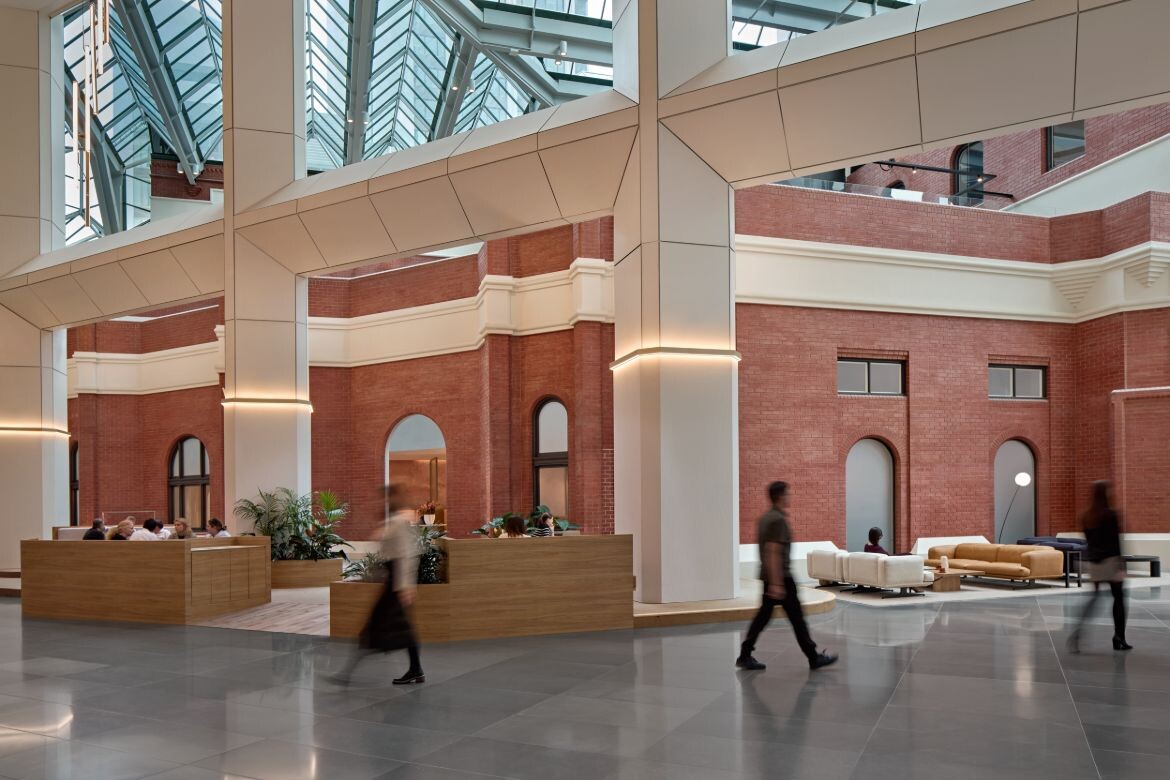NBRS Architecture have transformed one of the oldest structures on Macquarie University’s campus – the Faculty of Science & Engineering’s Mitchell building – to create an energy and space efficient contemporary workspace that encourages collaboration whilst respecting the historical, social and aesthetic significance of the building.
“The Mitchell building at Macquarie University was built in the mid 1960s; it’s one of the oldest buildings on the Macquarie University site,” says Andrew Duffin, design director at NBRS.
“Before we got there it was what you’d expect of an old academic building – brick walls, single corridors with little rooms, quite dark, dusty, cold and academic. It hadn’t changed for 40 or 50 years.”
Duffin and the team at NBRS Architecture saw the age of the building as no obstacle, however. Knocking down the building and replacing it with something ultra-modern was out of the question. Instead, they worked with the existing structure, reinvigorating the bones and subtly bringing the Mitchell building into modern day.
Perhaps the biggest transformation for the building is the new atrium – a three-storey glass thoroughfare which connects the Mitchell building to the adjacent E7B building. Bathed in natural light and with a view to the main quadrangle, the atrium replaces a space that was once a cold, dark wind-tunnel.
The addition also improves street presence and creates a sense of arrival into the building. “Actually, my favourite element of the project would be the steel-framed entry portals at the ground level of the atrium,” says Duffin. “They identify a sense of navigation through architecture. There’s no need for signage, you just know where the front doors are (there are three). It’s not a massive element of the project, but that’s a detail I really like.”
The atrium features a polished concrete flooring, which represents the transition from outdoors to indoors, and vice versa. The use of simple and honest materials such as this also marries the contemporary addition with the existing building, which is comprised clinker brick and exposed concrete. “Our job was not to fight the natural patina, but work with it,” Duffin says.
Modern colour pops punctuate the main building, notably a bright red, which highlights the building’s core. The core was originally positioned within the structure’s footprint, but NBRS Architecture decided to pull it out and run it up the outside of the building in order to save precious floor space. The standout red that coats the core now hugs the side of the building, clearly highlighting amenities for visitors and students.
Sustainability was also key within the project, and in order to help support the University’s One Planet ecological footprint target, the existing façade was retained, significantly reducing the job’s carbon impact, while high performance glazing was used to reduce solar heat gain, and natural ventilation was maximised throughout.
“This renewal is a perfect example of the benefits of retrofitting rather than rebuilding. By unlocking the potential of the existing building, we have provided a more sustainable workspace for the next generation of academics,” says Duffin.
“The building had already lasted around 50 years, so to give it another life as opposed to knocking it down is a great thing. Who knows, maybe there’s another 50 years in it.”
.
INDESIGN is on instagram
Follow @indesignlive
A searchable and comprehensive guide for specifying leading products and their suppliers
Keep up to date with the latest and greatest from our industry BFF's!

Elevate any space with statement lighting to illuminate and inspire.

BLANCOCULINA-S II Sensor promotes water efficiency and reduces waste, representing a leap forward in faucet technology.

Schneider Electric’s new range are making bulky outlets a thing of the past with the new UNICA X collection.

In this candid interview, the culinary mastermind behind Singapore’s Nouri and Appetite talks about food as an act of human connection that transcends borders and accolades, the crucial role of technology in preserving its unifying power, and finding a kindred spirit in Gaggenau’s reverence for tradition and relentless pursuit of innovation.

fjcstudio leads by design and the practice’s Melbourne studio is making quite the impact on the built landscape of Victoria.

Designed by architects Populous and Tyrrell Studio, construction has begun on the NSW Government’s $309 million redevelopment of Penrith Stadium led by John Holland Group.
The internet never sleeps! Here's the stuff you might have missed

So many product launches – where to begin with Milan? Well, across some of our favourite brands and all kinds of areas, here are some of the highlights we saw this year.

Woods Bagot has completed a lobby refurbishment inspired by the historic architecture of the Palace Hotel.

In design, the concept of absence is particularly powerful – it’s the abundant potential of deliberate non-presence that amplifies the impact of what is. And it is this realm of sophisticated subtraction that Gaggenau’s Dishwasher 400 Series so generously – and quietly – occupies.